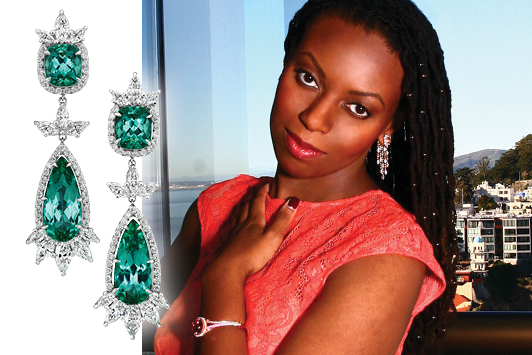
Before becoming an award-winning designer, Alexia Connellan was a passionate gemstone collector. She would go to the main fairs, and when a stone captured her expert eye, she would start asking the dealer questions. Uppermost in her mind then, as now, was the impact that sourcing a specific gem would have on the community it came from. In her design practice, she uses ethically sourced colored gemstones from artisanal and small-scale miners (ASM), and recycled, post-consumer diamond melee whenever possible. From an aesthetic point of view, she says she prefers old-cut diamonds.
Producing jewelry in an ethical and sustainable fashion suits her overall vision. She often uses old stock, whether it was mined over 25 years ago and never sold, or was simply forgotten in the back of the cutter’s safe. She applies the same thorough checks to the other materials she uses in her jewels, sourcing platinum from a refiner that buys the metal from conflict-free sources and provides signed documents from all the suppliers. She purchases recycled gold from a Scientific Global Services (SGS)-certified supplier.
The recipient of three American Gem Trade Association (AGTA) Spectrum Awards, the New Jersey-based Connellan has been an advocate for change, hoping to encourage people in the industry to take small, incremental steps toward more sustainable sourcing.
What does sustainability mean to you?
Sustainable means different things to different people. Some people are primarily concerned with the environment, some are more concerned with the lives and well-being of people in mining communities, and others are concerned with a combination of both. I am concerned with both, but for me, the lives and well-being of people will always come first. That is why I do not support a large company buying/leasing land from a country and pushing the local people who used to mine there out of a livelihood. Sure, it might be more “environmentally sustainable” and receive all the right certifications, but if it’s not helping local people live good lives where they can feed their families, then it’s no better in my mind. They won’t care about the cleaner water or air unless their basic needs are met. That is why I think the local people must be asked what these large corporations can do to better their lives and futures. Those large companies should help them, considering that they make such large profits by using those communities’ natural resources. I guess you could call it “compassionate capitalism.” If you are negatively impacting the local community, then no matter how many certifications you get, you are not truly “sustainable” in my mind.
Is it more expensive for a designer to buy responsibly sourced gems?
There is a general thinking that sustainably sourced gems do tend to cost more than ones that are not. This is definitely true for gems that are offered by bigger companies and large mining operations. They must pay a large premium to get an outside source to certify their operations and process — if they are honest! However, it is possible to find reasonable — and even “cheaper” than standard-priced — sustainably sourced gems, but it takes more work. You must be willing to work with smaller suppliers, ask more questions, take more time, ask around, and verify that what they say is true. Doing this, you can find great sustainable gems at a great price. I recommend going to gem fairs and asking lots of questions, going directly to a gem cutter, or sourcing from someone with a background in geology and/or gem mining. The closer you get to the source, the lower the price. This just takes more time, determination, and risk assessment and management.
Looking back on your experiences seeking the most holistic approach to your designs, what would you do differently?
The sourcing for the pieces [featured here] happened between 2006 and 2016. If I had to redo them now, I’d try and get 100% post-consumer diamonds, as I have learned that Canadian diamonds have greater environmental and social issues than I knew of at the time. I’d also aim to get ASM gold as opposed to recycled gold. But it’s all a good start! My sourcing isn’t perfect, and I get better each time I create a piece. But my intention to do good for the environment and help people on the ground has remained the same.
alexiaconnellan.com
Article from the Rapaport Magazine - August 2021. To subscribe click here.